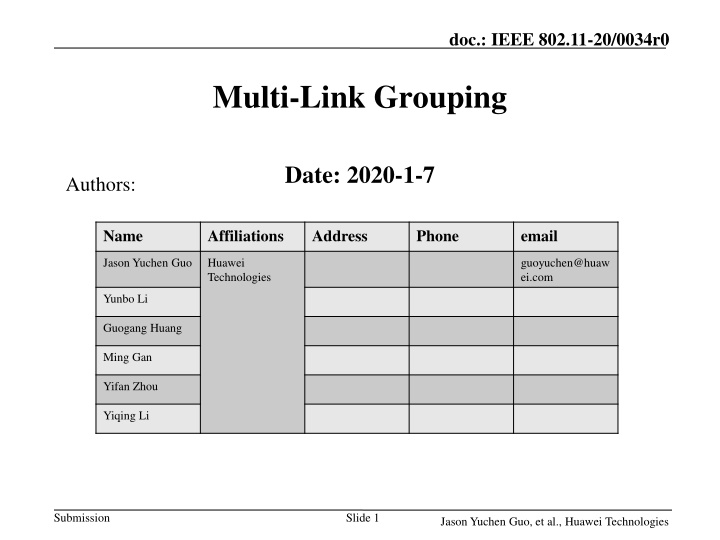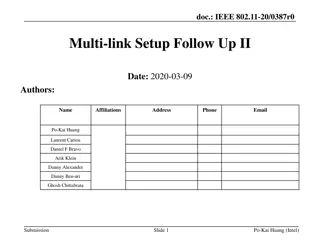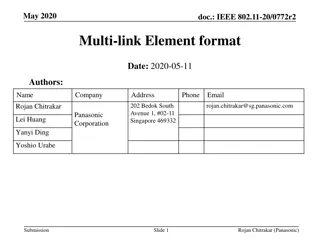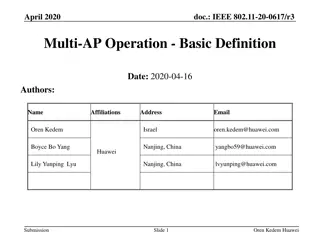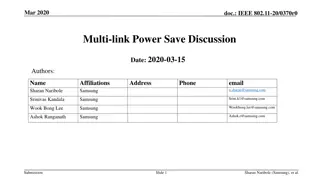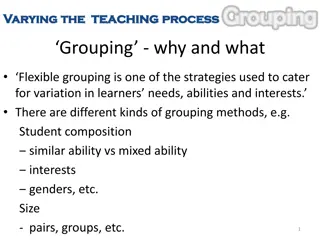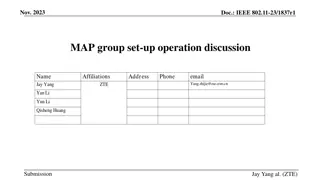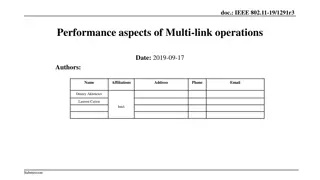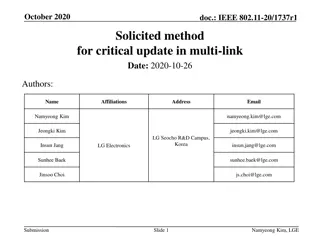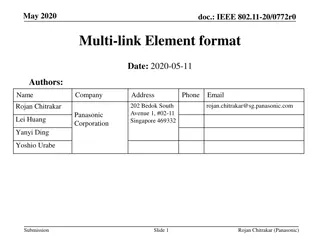Proposal for Multi-Link Grouping Method in IEEE 802.11-20/0034r0
Discussion on channel access schemes for multi-link transmission and proposal of a method to group non-STR links for synchronized and asynchronized modes based on AP MLD capabilities. Importance of link grouping and implications on EDCA usage emphasized.
Download Presentation

Please find below an Image/Link to download the presentation.
The content on the website is provided AS IS for your information and personal use only. It may not be sold, licensed, or shared on other websites without obtaining consent from the author.If you encounter any issues during the download, it is possible that the publisher has removed the file from their server.
You are allowed to download the files provided on this website for personal or commercial use, subject to the condition that they are used lawfully. All files are the property of their respective owners.
The content on the website is provided AS IS for your information and personal use only. It may not be sold, licensed, or shared on other websites without obtaining consent from the author.
E N D
Presentation Transcript
doc.: IEEE 802.11-20/0034r0 Multi-Link Grouping Date: 2020-1-7 Authors: Name Affiliations Address Phone email Jason Yuchen Guo Huawei Technologies guoyuchen@huaw ei.com Yunbo Li Guogang Huang Ming Gan Yifan Zhou Yiqing Li Submission Slide 1 Jason Yuchen Guo, et al., Huawei Technologies
doc.: IEEE 802.11-20/0034r0 Introduction The channel access scheme for multi-link transmission has been discussed in many contributions [1-6]. Several channel access modes are proposed: Asynchronzied channel access mode Synchronized channel access mode Quasi-asynchronized channel access mode Different channel access modes are suitable for different type of devices For STR capable multi-link devices (MLDs), asynchronized mode is good enough Independent channel access in different links, no impact of each other, easy to implement For non STR capable MLDs, synchronized (or quasi-asynchronized) channel access mode should be used to avoid the situation that the MLD is transmitting on one link, while receiving on the other link. Since MLDs with different capabilities may exist in the network at the same time, it is necessary to have a mixed mode, which is a combination of the above mentioned modes. In this contribution, we propose a multi-link grouping method which serves such a purpose. Submission Slide 2 Jason Yuchen Guo, et al., Huawei Technologies
doc.: IEEE 802.11-20/0034r0 Basic Idea The basic idea is to put the non-STR links into a link group, the links that belong to the same group should use the synchronized mode, while the links from different groups can use the asynchronized mode. The link grouping is only done on the AP MLD side: For those links that the AP MLD can not support STR, they should be put into the same link group. For those links that the AP MLD can support STR with all other links, they can form an independent link group. There is one primary link for each link group, EDCA can only be done on the primary link For the non-primary (or secondary) links, they can only be used together with the primary link. Similar method of the 80+80 channel access can be used, i.e., PIFS idle before the backoff done of the primary link means the secondary link is idle, in which case the secondary links can be used in synchronized mode with the primary link. Submission Slide 3 Jason Yuchen Guo, et al., Huawei Technologies
doc.: IEEE 802.11-20/0034r0 Basic Idea An important point of the link grouping architecture is that: if multiple links are in the same group, then EDCA can only be done on one of the multiple links Let s have a look what happens if EDCA is allowed on more than one links. If the AP MLD only uses one link, then other STAs may transmit to the AP MLD on the other link, but the AP MLD can not receive AP MLD 1 Link 1 STA MLD 1 Channel Busy AP MLD 1 Link 2 STA MLD 2 Simultaneous TX&RX happens Note: Quasi-asynchronized channel access mode proposes that the AP MLD can occupy the link 2 as long as the channel becomes idle, but it is not guaranteed, i.e., other STAs may still jump in. Submission Slide 4 Jason Yuchen Guo, et al., Huawei Technologies
doc.: IEEE 802.11-20/0034r0 Basic Idea Another important point of the link grouping architecture is that: if multiple links are in different groups, then EDCA can be done on each of the multiple links, no matter the STA MLD supports STR among these links or not Suppose there is a Non-AP MLD2 which does not support STR on link 1 and link 2, then the following rules can be designed to work well Hence, there s no necessary to do the link grouping for each individual STA MLD Link 1 Link 2 AP MLD1 TX to non-AP MLD2 If TX to non-AP MLD2, then the ending time should be aligned with link 1; If TX to other STAs, no restriction TX to other STA No restriction RX from non-AP MLD2 EDCA TX to other STAs RX from other STA No restriction Before identify the TA, RA for a RX pkt EDCA, TX to async MLD STA or single link STA Non-AP MLD2 TX to AP MLD1 If TX to AP MLD1, then the ending time should be aligned with link 1 RX, RA is broadcast addr or itself Pending backoff RX, RA is neither broadcast addr nor itself EDCA, TX to AP MLD1 Before identify the TA, RA for a RX pkt pending backoff Submission Jason Yuchen Guo, et al., Huawei Technologies
doc.: IEEE 802.11-20/0034r0 Link Grouping principle How to do the link grouping? In simple words, just put the non-STR links into the same group, so that the links in the same group behave synchronously. After link grouping, the following condition shall be satisfied: For any two links that belong to two different link groups, the AP MLD can support STR on the two links In most cases, if there are more than one link in a link group, for any link L within a link group, there exists at least one other link L* inside the same group that the AP MLD does not support STR on L and L*, since otherwise, L can form another link group. Let s take the following example to explain why we need such a link grouping principle Submission Slide 6 Jason Yuchen Guo, et al., Huawei Technologies
doc.: IEEE 802.11-20/0034r0 Grouping example Here is an example for the link grouping. Assume the AP MLD has 4 links: L1, L2, L3 and L4 The AP MLD does not support STR for the following link pairs: <L1, L2> ; <L2, L3> Meanwhile, it supports STR for the following link pairs: <L1, L3> ; <L1, L4> ; <L2, L4> ; <L3, L4> Then the 4 links can be divided into two link groups: Group1 = {L1, L2, L3} ; Group2 = {L4} L1 Do not Support STR L2 Group 1 Support STR Do not Support STR L3 Support STR L4 Group 2 Submission Slide 7 Jason Yuchen Guo, et al., Huawei Technologies
doc.: IEEE 802.11-20/0034r0 Operations of the AP/non-AP MLD under link grouping If only one link group is used for transmission, then the AP or non-AP STA MLD can perform EDCA on the primary link of the link group, secondary links can be used if PIFS idle If more than one link groups are used for transmission, then the situation is: AP supports STR between different groups, but STAs may or may not support STR between different groups. Given a particular link group G1: If the non-AP STA MLD supports STR between G1 and all other link groups, then the AP MLD or non-AP STA MLD can work independently on the link groups to transmit to each other If there exists a link group G2 that the STA MLD does not support STR between G1 and G2, then AP side: the AP MLD can only use G1 to transmit to the non-AP STA MLD as long as the non-AP STA MLD is not transmitting on G2 Non-AP STA side: The non-AP STA MLD can only use G1 to transmit to the AP as long as the non-AP STA MLD is not receiving its own packet on G2 Note that further rules may be defined, see slide 5. Submission Slide 8 Jason Yuchen Guo, et al., Huawei Technologies
doc.: IEEE 802.11-20/0034r0 Conclusion We propose a link grouping based channel access architecture for multi-link operation, including Link grouping principle Operations of the AP and non-AP STA MLDs Submission Slide 9 Jason Yuchen Guo, et al., Huawei Technologies
doc.: IEEE 802.11-20/0034r0 Straw Poll Do you support to have a link grouping based channel access method for multi-link operation in TGbe? Submission Slide 10 Jason Yuchen Guo, et al., Huawei Technologies
doc.: IEEE 802.11-20/0034r0 References [1] 11-19-1116-04-00be-channel-access-in-multi-band-operation [2] 11-19-1548-01-00be-channel-access-design-for-synchronized-multi- links [3] 11-19-1541-01-00be-performance-aspects-of-multi-link-operations- with-constraints [4] 11-19-1546-00-00be-legacy-performance-impact-on-multi-link- operation [5] 11-19-1405-07-00be-multi-link-operation-channel-access-discussion [6] 11-19-1916-00-00be-mlo-asynch-qsynch-synch Submission Slide 11 Jason Yuchen Guo, et al., Huawei Technologies
